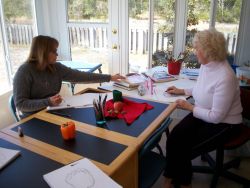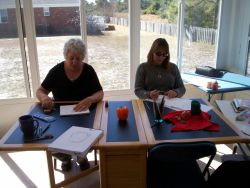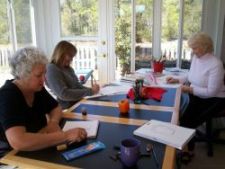Art Therapy In Instruction
Art Instruction Can Be Therapeutic!
When Creativity is Discouraged
What I have learned after over thirty years of art teaching, is that art is therapeutic for many students. The application is generally as follows: A person will come to one of my art classes with the hope of relieving the creative hunger they have had for years. There is almost always a reason why the hunger was there originally and why it was delayed or squelched. Many times, unfortunately, it is an instructor who, by some condemning words, caused the person to give up entirely on any creative endeavor.
And yet, the desire lived on within them. Many times, over a period of twenty or thirty years, that repression has continually existed and the person has regularly been frustrated by the urge to create and the brick wall that was built in front of that urge many years ago.
How It Happened
I can honestly say that at least forty percent of my students relate some incident or experience with a teacher or instructor that has destroyed their creative abilities that were burgeoning at the time. Then, there is the smaller percentage of students that give accounts of being discouraged or harshly criticized by a parent, sibling or relative for doing something creative--this could range from drawing, painting, creating a play, experimenting with cooking or even building a play house.
Encouraging Creative Development
I have written basic lessons to address this problem, designing exercises that teach skill and technique, but are also fun and not intimidating. When students successful complete an art skill, they have developed some confidence and feel good about what they have accomplished. Although I also encourage students, I find that when they develop a specific ability to create something, for example, learning how to shade a circle so that it looks like a sphere, the achievement alone is the best reward for the student.
Increased Information-Rich Learning
As new skills are learned, students develop more confidence in their creative abilities. Learning skills demand time and effort from the student, but the payoff is mastering the skill and coming away with a drawing, painting, collage or water color that is suitable for framing. Slowly, more exercises are introduced, building on the skills that the student now knows and combining that with a new skill.
My classes are small and I can guide each student individually. This is a definite advantage, as I have found it larger classes, personal guidance is difficult and many students slow down and sometimes get stalled doing an exercise.
What I Learned As An Assistant Teacher
Years ago, I was assisting an art instructor at a museum school. The instructor would set up a large and complicated still life of many different objects (fruit, potted plants, books, umbrellas, a coat rack, etc.) He then told the students to draw it and left the room until near the end of the class, he would appear again and begin to critique (analyze) each students work. Often his criticisms were harsh and his recommendations to correct the student's mistakes were brief and not very clear.
I could see that a lot of the students were becoming discouraged and attendance diminished to three or four stalwart students. The instructor attributed this dropout rate to the students' inability to grasp what art entailed. I personally felt the whole instructional methods employed by the instructor were at fault, and if he had taken time to guide each student during the session instead of leaving the room, not only would attendance remain the same, but the students would have actually learned something

How I Solve The Negativity Problem
When I started to instruct art classes, I limited the number of students that could attend so that I could deal with each student individually. I constructed exercises that were easy to begin with and that would lead to an ever increasing knowledge and mastery of the subject (drawing, painting, collage, printmaking, etc.) To this day, every lesson offered in Free Online Art Classes is constructed around the philosophy that every student is encouraged to create, learn the basic and develop their skills gradually. I find that this method, over thirty years, has worked quite well.
Negative Dialogue
What I also have learned over the years is that not only is the dialogue between myself as instructor and the student important, but dialogues between the students are important, also. For example, It has often occurred that there is one or two students in a class that verbalize their apprehensions to learning to create anything. In a drawing class, a student might say out loud, "Oh, I just can't do this! I just don't have it, I guess. I'm not an artist. This is too hard." When the other students hear this, they are affected in a negative way and they might also begin to doubt that they can do an exercise successfully.

So, on the first day of the class, I talk to the students about how their brain is split into two hemispheres: the right and the left, and how, especially early in the learning process, there can be a conflict between these two hemispheres. Often the left hemisphere, which seeks to define, chart and explain phenomena, is not comfortable with the creative process, which relies not on definition or explanation, but seeing and reiterating what is seen. A great and seminal book written on this problem is Betty Edwards' "Drawing On The Right Side Of Your Brain."
Once students are aware of this conflict between their two hemispheres, they can control it by choosing to not accept a left brain feeling of "It's a book! Why have to draw it! I KNOW what it is!" and going into the right brain mode of looking carefully at the subject matter and applying the draw-what-I see technique.
It becomes often a source of amusement as students experience the push/pull between their two hemispheres. Often, a student will say to another student, "Hey, I hear you groaning. Come on, get into the right side and have fun!" Or, "I can feel there is a kind of wrestling match going on inside my head."
What Is The Therapy?
There is no doubt in my mind that students who come away from a class feeling encouraged and even elated by their own learning process and artistic endeavors will return to the next session with not only, successfully produced exercises, but a positive attitude. I do consider this a good therapeutic alternative to what was a degrading, frustrating and negative experience in the art museum instructor's class years ago.
I made the choice to write all of my courses to be not only information-rich, but easily accessible and workable for every student. Students learn differently, some will be slow at grasping a skill or concept, others will speed right along, successfully completing an exercise and moving on to the next. I am there for all of them--to encourage and guide. I demonstrate skills and techniques when necessary, so students can more quickly grasp what it is they have to do. I work with slower students, encouraging their efforts and I give faster-moving students exercises that will help develop their learning skills further.
In this way, art-learning becomes more than a skill to be learned, but a way of enrichment or perception and visual awareness that sensitizes us towards to beautiful and wonderful things our world has to offer.
Click here to go to the FREE Art Therapy page
Real Feedback

9/15/13
Hi Lois, thought I would send you a quick note to tell you how much I appreciate your YouTube videos. I found you last December when I purchased a Breville smart oven. I'd never really used a toaster oven for anything other than toast and since finding you I've been cooking like crazy! My husband thinks that's wonderful.
Also I introduced my daughter to your art lessons and she is delighted, especially with the stencil one of the fishes! You encourage people of all skill levels to feel less intimidated by the thought of actually 'doing' a painting!
Anyway, just saying thank you and to let you know how much we enjoy Charlie as well. Kindest regards,
Carol
-----
Hello Lois. Thanks for giving me the opportunity to learn hoy to draw and paint in diferentes styles and techniques. I just started and I've never had taken any classes til now with your tutorial.
I really worldwide appreciate your comments about my still life exercise. I specially have problems with shading the table and painting the wood graining (as you can se in the picture) and also the table cloth. The melon sas difficult too, I feel something is missing there too . (Some things in the picture I didn't want them to apear in my painting)
I'm starting to work with the landscape. As son as I have ir done I'll send you the picture.
Best regards and thank you again.
Andrea Berkefeld (from México)
-----
Lois, Thank you so much for this video.You have really outdone yourself on this one. I am truly inspired to give this a try! This is really stunning! I love it. I wanted you to know that you have been a real blessing to me. After the sudden passing of my husband (of 33 yrs.) I decided to take up art, and your site was one of the first I came across. It was, and still continues to be one of my favorite sites for inspiration and relaxed learning. You're a gem. Keep it up! Thanks Much Kim Tanner
---
I discovered your website today and I am so impressed by the content. Not only it is free but is far superior to other websites.
My name is Dena and I'm from Queensland in Australia. Just recently (few weeks ago I picked up a paint brush and love it!!! I'm a Mother of 4 and 46 this year, work full time real estate sales.
I've never had an art lesson and was surfing the Internet for free tutorage on acrylics. That's how I discovered your incredibly helpful site.
You are the one that should be charging not the majority of other ones I have found.
My question to you is below is a painting that I'm trying to copy, however the running bits of paint at top I'm not sure how to get that effect.
I'm only on lesson one of yours as I just discovered it only hours ago. But if you would share with me how to achieve this it would be greatly appreciated. Again, thank you for such rich information on your site. I'm so excited to get to experiment with all you share
THANK YOU :)